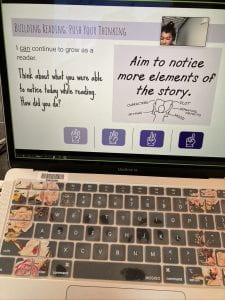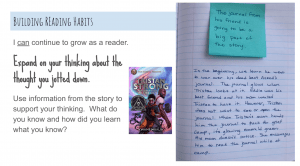Hybrid Reading 2020
The Technology Hustle
If you would have told me last year at this time that I would be in a classroom with some kids in-person and some at-home, I would have looked at you funny. Who could have guessed that we would be juggling the different modes of instruction with in-person and virtual at-home students in the same moment! However, the innovator and experimenter in me is actually enjoying the ideation of how to make this come together.
I regularly ask myself, How did I do this before and how can I do it now in a rich, meaningful way?
I choose to explore and try out a new blend in the classroom. It’s been some moments of trial and error. Suddenly, there are the beautiful moments. Yes, those teaching moments where it just clicks. It’s still happening! This journal is about one of those moments of growth for my students and their interaction with each other.
The Reading Lesson Method
Model |
|
We are starting each lesson with a focus and purpose for reading. The focus of this lesson was to work on having a thinking moment while reading.
After we go over the reading goal, I always share with the class a book that I have been reading with modeling of the strategy. I set up my own notebook and with digital instruction, I add a lot of pictures to my slides on Canvas. This allows both in-person and at-home to see the modeling clearly. |
Engage |
Students then spend twenty minutes reading the books they have selected. The learners at-home are put in individual break out rooms for the reading time. During this time, I do reading conferences with readers. I conduct one with a reader online by going to the break out room of the student. Then I switch to a conference with a reader that is in the room. I keep alternating with my readers during the twenty minutes. I keep notes on each reader in a binder-not all things are high tech!
The students were given a Post-It note to jot a thinking moment during the twenty minutes. |
 |
Practice |
Next we moved into a time of practice. The students worked on extending their thinking. I shared with them some previous student examples. Then they were given time to put the Post-It note in their reader’s notebook and extend their thinking after the reading session. |  |

When a student wants to type, I have them take a picture of the Post-It and then upload the picture to the Notes App. |

Just look at that great development to thinking!
|

|
Reflect |
 |
The fun came when the students were done working. The students were shown the reflection tool for the day. They were asked to re-read their work and rate their performance. If they needed to make changes they were able to do so. Next, we opened up classroom space to share the thinking and writing. The kids were excited to volunteer. My students at-home volunteered to read their work. You can see that on my laptop, which was projected on the screen for in-person to see. The in-person then gave feedback for the at-home student. The magic sparkle arrived on faces when feedback was given and received. |
 |
Students in-person shared by coming to the iPad stand to read their work and allow them to be seen on Zoom. The at-home kids gave the in-person student feedback. Both groups were able to share great books, thinking, and smiles. It felt like the “normal” days of reading instruction! |  |





